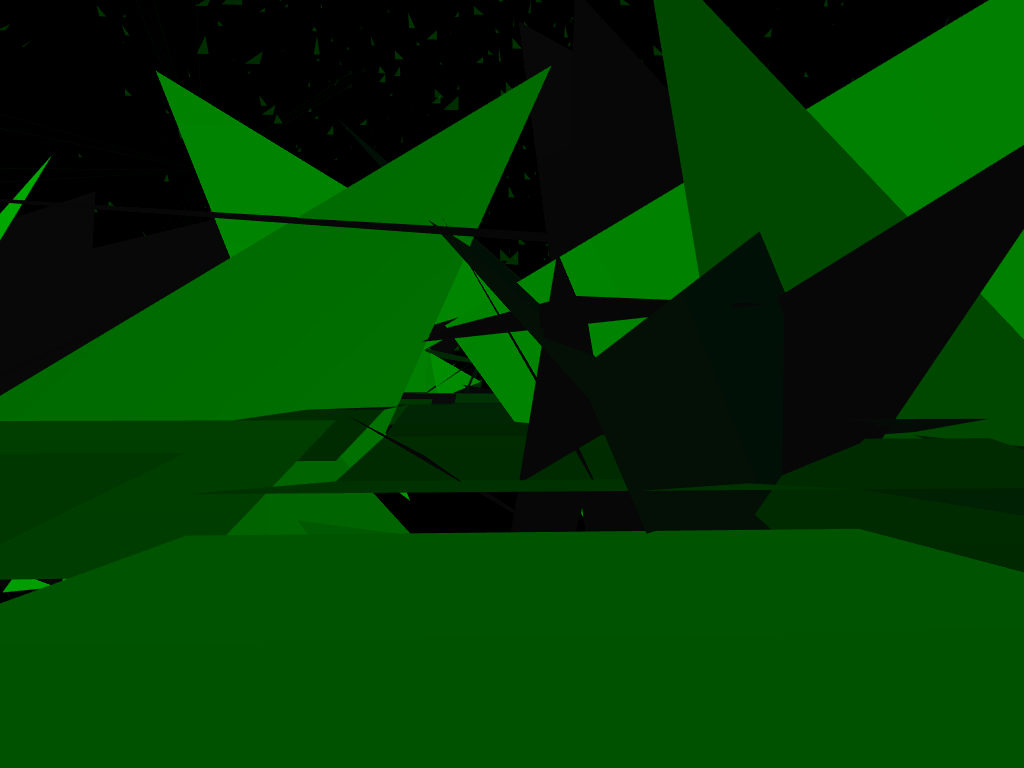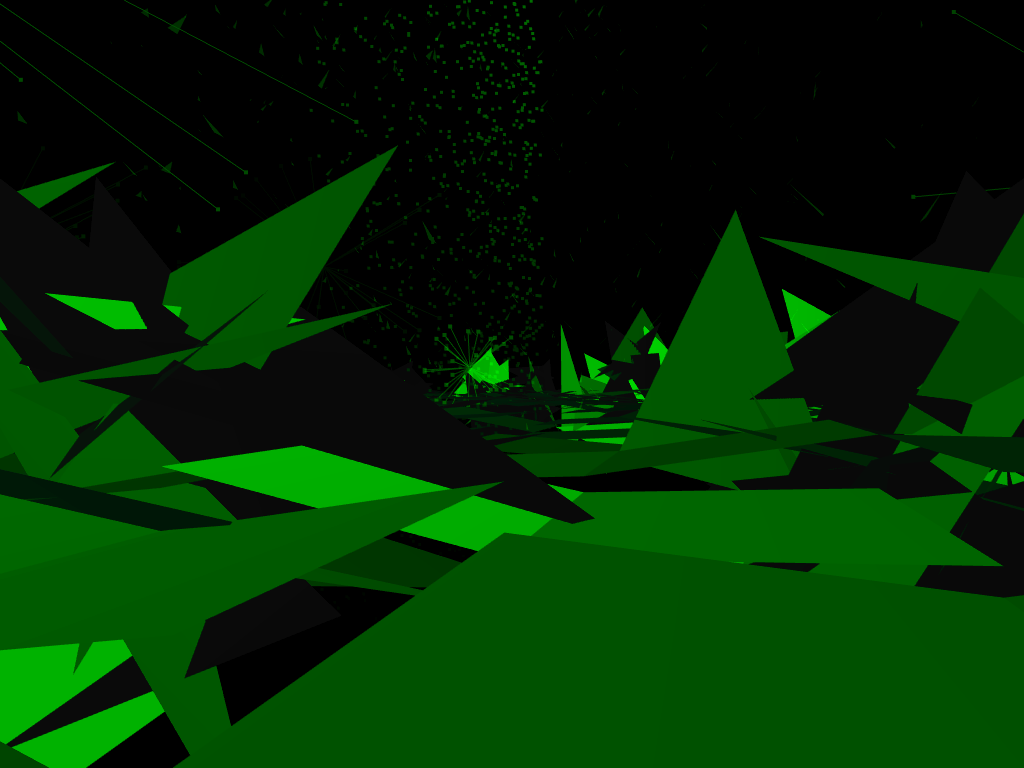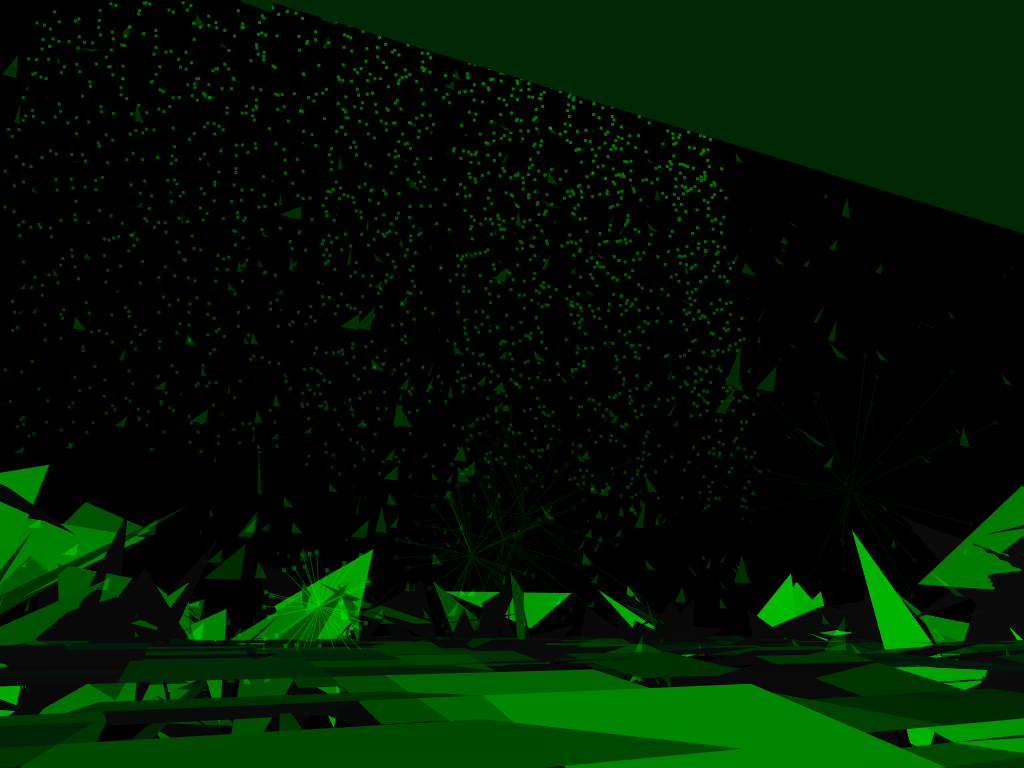Escena.org dentro v2 by xplsv
This demo was released at Inspire, a new demoscene gathering held in a small town north of Spain, with the aim of promoting escena.org, the spanish demoscene website. There was already another promotional demo done by elerium core in 2001, but I thought it would be interesting to have a newer one to kick things off.

It is very, very calmed. I had thought at the beginning about doing something very demoscene-ish, just as the previous promo demo was, but then I found myself not wanting to redo yet again the same old school effects, and headed towards something a bit more abstract. Then I remembered about eb7m's 3400 miles below
and suddenly lots of ideas came to mind!
The tech stuff
The biggest change compared to previous demos which I've coded is that I used a scripting engine instead of writing everything in C++, and recompiling every time I wanted to change a parameter. For this I've finally used Lua, after considering Ruby and Python. The nicest thing about Lua is that it is really easy to embed. If you want to embed Ruby or Python, it's a completely different (and long) story, but with Lua you just build the library (with a nice makefile which they provide already and just works™) and link to that library in your project, and that's it. You can then create as many instances of Luas as you want, and they won't interfere with each other. In my case I just use one, which loads and executes the demo script (demo.lua).
The second nicest thing with Lua is the way in which you pass parameters between C and Lua. It is very simple, with functions such as lua_tonumber, or lua_tostring; if you compare with Python for example, it is way more verbose.
In the demo script you can access several functions which I created in C and exposed (registered) to Lua. So for example, there's a function for loading a song in C and once I say to Lua: hey, there's this function in C that you can use!, you can write loadSong("filename") in the script and it will end up calling the music library (in this case, BASS, but it could be any other one that we want. For example, it was fmod at the beginning) through the C function.
The syntax and function naming is highly inspired by Processing's syntax.
This was also a bit of a benchmark for Lua, so instead of using the typical Vector3D, Face and Mesh C++ classes I decided to implement a reduced subset using Lua's metatables. Even normals are calculated using Lua's math library! Considering the insane amount of stuff which is going on there (I basically increased the number of things such as particles, terrain segments, etc, until the frame rate began to be a little bit jerky), I think it performs very decently. Next step would be to optimise what is sent to opengl, since currently not only everything is drawn in immediate mode but also nothing is culled at all.

Why does it look like that?
Since the song's title is 3400 miles below
, I thought of building something like an underwater world. A very deep one indeed, since sun rays do not even reach that depth, and so any ship which wanted to explore that area would need to use their own light - hence the light is needed for illuminating where we are looking at ;-)
I first built the ground. Initially I thought about calculating an evenly distributed matrix of points and then randomize the heights so that they formed something such as a terrain, but it looked too usual - so I broke some things here and there and that's why it looks as if the tiles are misplaced.
Then I wanted some kind of life in there. But life in very deep waters doesn't resemble the usually depicted fishes. It's more about strange entities, and so I thought of those strange spiders which are in the scene. They are simply there, waiting for something while their legs oscillate.
But it was still too plain. I went too creative and added some plankton, which actually is quite wrong (plankton isn't present at that depth). The plankton is abstracted with those little triangles which go up. In fact they shouldn't go up but down, since they are created and fall from above, but in this case they contribute towards the how odd, things are moving upwards
feeling.
In the quest for making it a bit more sinister and mysterious I also added fog. I think it's the first time I use fog too! It was a black fog so that colours got even darker with the distance.
And then I began with the particles-text effect. I didn't want to load and analyze a bitmap to find out where the points were, so I remembered about those naive drawings we did with PRINT in Basic, and did this:
escena = {
"XXXXXXXXXX XXXXXXXXXX XXXXXXXXXX XXXXXXXXXX XXXXXXXXXX XXXXXXXXXX XXXXXXXXXX XXXXXXXXXX XXXXXXXXXX",
"XX XX XX XX XX XX XX XX XX XX XX XX XX ",
"XXXXXXXXXX XXXXXXXXXX XX XXXXXXXXXX XX XX XXXXXXXXXX XX XX XX XX XXX",
"XX XX XX XX XX XX XX XX XX XX XX XX XX",
"XXXXXXXXXX XXXXXXXXXX XXXXXXXXXX XXXXXXXXXX XX XX XXXXXXXXXX XX XXXXXXXXXX XX XXXXXXXXXX",
" "
}
which is a table with strings. When loading the demo and preparing the effects, I go through each string and if there's an 'X' I store a new point in the list of particles to draw. Actually, I created several particles for each point so that the fountain of particles was a tad denser. Then in each frame they move a little bit towards their final destination. To make it more subtle too, I made the alpha dependent of the height, so that transparency decreased with height.
The problem was that everything was still too evident. Something else was needed in order to hide stuff and avoid showing everything from the beginning. So that's why I added several randomly sized but circularly distributed meshes around the center of the scene. They even look sort of kryptonitic to me!
And why is everything green? Because our ship has only got a very old green phosphorus monitor, so it can only display things in green shades. Apparently ;-)

Sources
The code is in my git repo:
- Browse it
- Check it out:
git clone git://github.com/sole/demoscene.gitThen it is in the releases/xplsv/eorg_dv2 directory
Thanks
Of course big thanks to Pplux for his awesome explanation about how the stack in Lua works. That was all I needed to take off!
I'd also like to thank Corsario for offering his computer as compo machine...
And finally thanks to Inspire organizers for all the enthusiasm they have put into this new event. Let's hope we can release lots more of demos in subsequent Inspire editions!